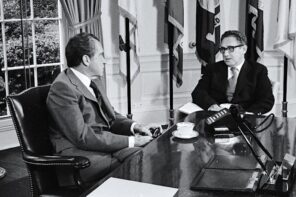There’s a big difference between what happened and what people think happened. Sometimes it matters less what happened, and more what people think did. After all, if we turned to the political right for history lessons, we might think slavery was good for families. But if we examine what people think happened, we can sometimes find something enlightening: How race and racism changes.
Take the “white” Europe Breivik claimed to be killing so many white people on behalf of. Then consider how casually Northerners deride Southerners in our country. The common, breezy disdain has its roots in hierarchies of whiteness: Protestant, Germanic, and Nordic beats Catholic, Gallic, and Latin. Since the 19th century, religious identity dimmed, but ethnicity took its place in a similar hierarchical firmament.
As the European Union stretched east, many grumbled that Eastern Europeans didn’t belong. They might be white on the outside, but inside—where it mattered—they were still dark. And now we have Breivik, part of a wider trend of anti-Muslim rage, which identifies Islam as a threat to the West. All of it. Breivik’s rhetoric was influenced by white power, Christian triumphalism, and European nationalisms, but he combined these to produce a nasty pan-European Christian identity movement.
This racism is different from others that came before. For one thing, it tries its best to avoid superseded racisms, claiming not to care about skin color, dwelling instead on more acceptable grounds for hate: cultural, religious, metaphysical, even sartorial. Whether you’re Orthodox or Catholic, atheist or agnostic, Protestant or non-practicing, it doesn’t care. It’s belonging to a generic European Christianity that makes you good, and your opposition to Islam that makes you smart.
Breivik’s not looking to undo the European Union but to establish its evil doppelganger, a little bit like Star Trek’s “mirror universe,” with what years ago would’ve made no sense: Rome in place of Brussels, Catholicism as a pan-Christian touchstone, and boundaries all the way into Russia. Unlike the current European Union, it will be run by real folk, not elitist Marxists, and be closed to Muslims.
Breivik launched his attack on July 22, and titled his manifesto “2083–A Declaration of Independence.” July 22 is the anniversary of the establishment of a Crusader kingdom in Jerusalem, while 2083 is 400 years after the Ottoman defeat outside Vienna, crucial to European salvation in the imagination of many Islamophobes.
In the wake of Breivik’s attacks, some are claiming he is merely a loner, and does not represent a genuinely dangerous trans-Atlantic discourse; still, Breivik’s manifesto quotes liberally from Islamophobic ideologues and blowhards. Others are introducing more nuance, suggesting that Breivik is the opposite of al Qaeda, and was instigated by their violence:
In the name of preserving a Christian Europe, Anders Behring Breivik conducted an ideologically inspired terrorist attack against those he believed were Islamist terrorist sympathizers. In many ways, this latest act of religious hatred, carried out in the name of cultural purity, signals the febrile acceptance of Osama bin Laden’s invitation to reignite the medieval holy war between Islam and the Christian West.
While the violence is similar, any similarity is tactical, not substantive. The instances Breivik approvingly cites (say, the war in Bosnia) pre-date al Qaeda’s prominence by years. To try to construct a chronology of responsibility is not going to clarify the reasons for this massacre; or give us ideas on how to prevent it.
The reason Muslim and Christian extremism resemble each other is because they are products of the same global processes, which transcend and subsume religions and regions and even nations. Global capital is stranding Western middle classes while empowering their counterparts in places like Turkey and China. The same process is at work; if even it produces different results. The same truth holds for radical violence, whether Muslim or Christian.
Terrorism preys on the weaknesses of the global system. But more than that, terrorism—in its current form—is inseparable from globalization. Just as transnational connections enable ever faster movement of goods and services, so too do transnational networks of terrorists plot across borders. And just as high-flying capitalists preach the virtues of turbulence, of a world endlessly reinventing itself, terrorists prey on those caught between worlds, unable to find their footing, and repackages their existential anxiety in a compelling kulturkampf.
For these reasons, we need to pay more attention to 2083 than 1683. People, unmoored, seek familiarity; and we can only articulate what we want and do not want in languages we already know. Breivik’s hate might hearken back to the 19th century, the 17th century, and even the 11th century—but it does so in order to speak to the 21st.




